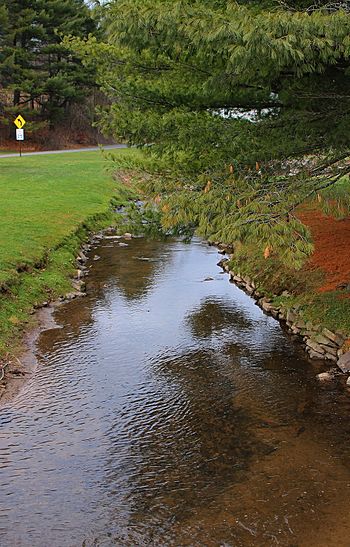Crab Run (Mahanoy Creek tributary) facts for kids
Quick facts for kids Crab Run |
|
|---|---|

Crab Run looking downstream
|
|
| Physical characteristics | |
| Main source | Barry Township, Schuylkill County, Pennsylvania, not far from the census-designated place of Beruys Lake 897 ft (273 m) |
| River mouth | Mahanoy Creek in Barry Township, Schuylkill County, Pennsylvania near Taylorville 742 ft (226 m) 40°44′56″N 76°23′22″W / 40.74880°N 76.38936°W |
| Length | 2.5 mi (4.0 km) |
| Basin features | |
| Progression | Mahanoy Creek → Susquehanna River → Chesapeake Bay |
| Basin size | 3.50 sq mi (9.1 km2) |
| Tributaries |
|
Crab Run is a small stream, also called a tributary, located in Schuylkill County, Pennsylvania. It flows into a larger stream called Mahanoy Creek. Crab Run is about 2.5 miles (4 kilometers) long. It flows entirely through Barry Township.
The area of land that drains water into Crab Run, called its watershed, covers about 3.5 square miles (9.1 square kilometers). Even though some parts of the stream are listed as "impaired" (meaning they have problems), Crab Run itself is not affected by pollution from old mines. This is because no mining has happened in its watershed. However, some parts of the stream are affected by farming activities.
Crab Run's watershed is a special area for fish. It's known as a "Coldwater Fishery" and a "Migratory Fishery." This means it's a good place for fish that like cold water and for fish that travel long distances. In 2001, scientists found tiny water bugs, called macroinvertebrates, living in the stream, but they didn't find any fish.
Contents
Where Crab Run Flows
Crab Run starts in Barry Township, not far from a place called Beurys Lake. It flows generally west-northwest for a short distance. Along its path, it goes through a pond or small lake.
After that, the stream turns and flows north-northeast. It then receives water from a smaller stream, called an unnamed tributary, that joins it from the left side. Crab Run then continues flowing northeast. A bit further downstream, another unnamed tributary joins it from the right side.
The stream then turns north-northwest for a short stretch, flowing next to the bottom of a mountain. Finally, Crab Run turns north-northeast again for a short distance. It passes through another pond or small lake before it meets and joins Mahanoy Creek. Crab Run joins Mahanoy Creek about 32 miles (51.6 kilometers) upstream from where Mahanoy Creek ends.
Water Quality of Crab Run
Some parts of Crab Run's watershed are considered healthy and not "impaired." However, other parts of the stream have some issues. One section is listed as having problems with metals, which is often linked to old mine drainage. But, as mentioned, no mining has actually happened in Crab Run's watershed.
Another part of the stream has problems with siltation (too much mud and dirt) and low dissolved oxygen. These issues are caused by farming and animals grazing nearby.
In August 2001, scientists measured the amount of water flowing in Crab Run. This is called the discharge. It was about 0.61 cubic feet per second (0.017 cubic meters per second). The water's pH was 7.1, which is close to neutral. The water also had a good amount of alkalinity, which helps keep the pH stable.
Land and Rocks Around the Stream
The lowest point of Crab Run, where it joins Mahanoy Creek, is about 742 feet (226 meters) above sea level. The highest point, where the stream begins, is about 897 feet (273 meters) above sea level. Crab Run is located south of a coal mining area known as the Western Middle Anthracite Field.
The bottom of Crab Run, called the streambed, is mostly covered with cobbles (small, rounded stones). However, there is also fine silt (very fine dirt) covering parts of it. The color of the dried mud from the stream is a dark yellowish brown.
Crab Run's Watershed Area
The entire area of land that drains water into Crab Run, its watershed, is about 3.50 square miles (9.1 square kilometers). The stream is completely within a specific map area called the Tremont quadrangle. The mouth of Crab Run is less than 1 mile (1.6 kilometers) from the small community of Taylorville.
History of Crab Run
Crab Run was officially added to the Geographic Names Information System on August 2, 1979. This system keeps track of names and locations of geographical features in the United States. Its special ID number in the system is 1172575.
In 1940, a concrete bridge was built over Crab Run in Taylorville. This bridge is about 24.9 feet (7.6 meters) long and carries Black Creek Road.
Animals and Plants in the Stream
The area that drains into Crab Run is a special place for fish. It's called a Coldwater Fishery and a Migratory Fishery. This means it's a good habitat for fish that prefer cold water and for fish that travel long distances to spawn. However, in 2001, no fish were found living in Crab Run itself.
Even though there were no fish, scientists did find many different kinds of macroinvertebrates (tiny water bugs and other small creatures without backbones) in Crab Run in 2001. They found a total of ten different types.
- Chironomidae (a type of midge larva) were "very abundant," meaning there were more than 100 of them.
- Simuliidae (black flies) and Hydropsychidae (caddisflies) were "abundant," with 25 to 100 individuals of each.
- Ephemerellidae (mayflies), Crydalidae (dobsonflies), Tipulidae (crane flies), Cambaridae (crayfish), and Oligochaeta (aquatic worms) were "present," with 3 to 9 individuals of each.
- Nemouridae (stoneflies) and Heptageniidae (another type of mayfly) were "rare," with only 1 to 2 individuals of each found.
Scientists use something called the Hilsenhoff Biotic Index to measure how healthy a stream is based on the types of macroinvertebrates found. In 2001, Crab Run had a value of 5.61, which helps scientists understand its water quality.

